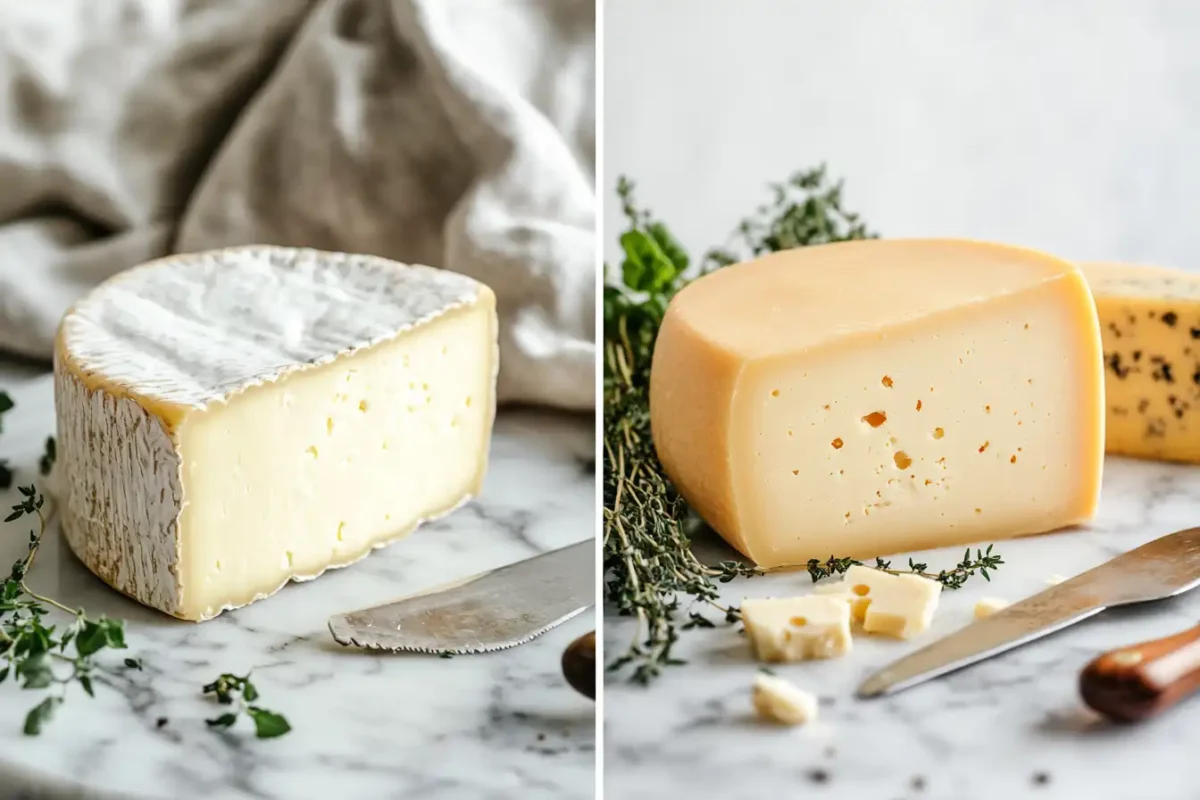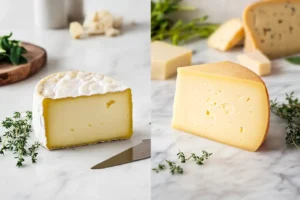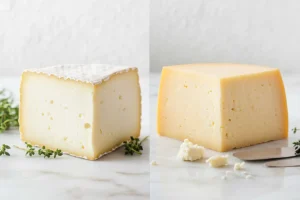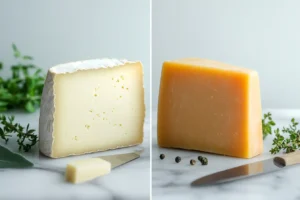Is Gruyere cheese the same as Gouda? This article explores the differences and similarities between these two popular cheeses, delving deeper into their unique characteristics.
Exploring the Nuances Between Gruyere and Gouda
Is Gruyere cheese the same as Gouda? This question arises frequently among cheese lovers and home cooks alike. While both are celebrated for their rich flavors and culinary versatility, understanding their distinct traits is key to appreciating each one’s unique contribution to the world of cheese. They are, indeed, quite different. Let’s embark on a comprehensive journey to uncover the nuances that set them apart.
Learn about Gruyère’s unique culinary appeal and why it’s a staple in European cuisine.
The Heritage and Craftsmanship of Gruyere
Gruyere cheese, a cornerstone of Swiss culinary heritage, originates from the lush pastures of Switzerland. Its production is a time-honored tradition, often passed down through generations. Made exclusively from raw cow’s milk, its crafting involves a meticulous process. This process includes curdling, pressing, and brine bathing, followed by an extended period of aging. This aging, typically spanning several months, is crucial for developing its complex flavors and firm, yet supple texture. Accordingly, its production method reflects deep-rooted traditions. Is Gruyere cheese the same as Gouda? Clearly not when considering its heritage.
The Dutch Legacy and Production of Gouda
Gouda cheese, representing the dairy prowess of the Netherlands, boasts an equally rich history. Made primarily from pasteurized cow’s milk, its production involves a variety of aging methods, from short maturation periods for young Gouda to extensive aging for mature varieties. The process includes curdling, washing, and pressing, then a brining stage, followed by aging in controlled conditions. This diverse aging process allows Gouda to display a wide range of flavor profiles. Therefore, Gouda has a wider range than Gruyere.
A Deep Dive into Flavor Profiles: Gruyere vs. Gouda
Gruyere cheese is characterized by its signature blend of nutty, earthy, and slightly sweet notes. Its flavor, which intensifies with age, is remarkably complex, revealing subtle hints of fruit and a pleasant tang. This multi-layered taste profile makes it a sought-after choice for gourmands. Is Gruyere cheese the same as Gouda in flavor? Absolutely not; Gruyere has a distinctive profile.
Gouda cheese, on the other hand, presents a spectrum of flavors based on its age. Young Gouda offers a mild, creamy, and buttery taste. Older Gouda evolves, developing caramel, butterscotch, and nutty notes. Its flavor can also exhibit hints of butter and a slight saltiness. This wide spectrum makes Gouda exceptionally versatile, allowing it to satisfy diverse preferences. Thus, its flavor is variable.
Textural and Visual Differences in Gruyere
Gruyere cheese has a uniformly firm and dense texture, featuring tiny, occasional eyes or holes. It maintains a smooth, consistent structure that provides a pleasant mouthfeel. Its color is typically a pale, straw-like yellow. This consistency is vital for its role in melting, ensuring it melts evenly and smoothly in dishes. Is Gruyere cheese the same as Gouda in texture and appearance? Once again, the answer is no.
Textural and Visual Differences in Gouda
Gouda’s texture ranges from creamy and soft in its younger forms to hard and dense in its older versions. It displays a smooth surface and can have a paler yellow color in its youth, developing a deeper, richer yellow or brownish hue as it matures. Its appearance and texture are directly influenced by its aging, unlike Gruyere’s more uniform presentation. Accordingly, texture and appearance are also points of difference.
Culinary Versatility: Exploring the Best Uses
The culinary applications of Gruyere cheese and Gouda cheese are extensive. However, their differences in flavor and texture make each one suited to particular dishes. Is Gruyere cheese the same as Gouda in its applications? Not entirely. Both are amazing, but for different reasons.
Gruyere’s bold flavor and superior melting capabilities make it a favorite in dishes where its character can really shine. For instance, it is excellent in gratins, quiches, and various French dishes. Its depth of flavor adds sophistication to these meals. Moreover, it’s perfect for those who like bold tastes.
Gouda, appreciated for its versatility, is found in a wide array of culinary settings. Younger Gouda is excellent in sandwiches and as a snack, while older Gouda brings complexity to cheese platters and pasta recipes. It’s also a great melting cheese, perfect for creamy sauces and other warm dishes. Therefore, it is adaptable for different dishes.
Optimal Recipes Showcasing Gruyere
Gruyere elevates recipes with its robust flavor. Classic dishes like Croque Monsieur and French onion soup are transformed with its inclusion. It is also essential in a genuine Quiche Lorraine, providing both flavor and a smooth melting consistency. Therefore, it is wonderful for dishes that require a powerful flavor.
Optimal Recipes Showcasing Gouda
Gouda is appreciated for its adaptable flavor, which makes it ideal for many recipes. It can be a star in grilled cheese, mac and cheese, and omelets. It can also be used as a topping for salads or a cheese board selection. Accordingly, it fits into different culinary contexts. Thus, it’s favored for its adaptability.
Nutritional Insights: Gruyere and Gouda Compared
From a nutritional standpoint, both Gruyere cheese and Gouda cheese offer beneficial nutrients but with slight differences. Is Gruyere cheese the same as Gouda nutritionally? Although both provide protein and calcium, their composition of macronutrients differs. Therefore, it’s important to look at the details.
Gruyere tends to have a somewhat higher fat content and calories than Gouda. It’s also a good source of calcium and protein. Consequently, it’s a good source of energy. However, this makes portion control important.
Gouda provides similar proteins and calcium. However, its fat content varies based on its age. It’s a valuable source of nutrients and is suitable for a variety of diets. Therefore, it can suit a diverse range of nutritional needs.
Detailed Macronutrient Composition of Gruyere
Gruyere’s nutritional profile includes significant protein, a high amount of fat, and a moderate amount of calcium. This makes it a nourishing option when consumed mindfully. Consequently, it’s important to consider the overall balance of your meals.
Detailed Macronutrient Composition of Gouda
Gouda provides a good balance of protein, fat, and calcium. Its variation in fat content with age makes it a more adaptable cheese for nutritional considerations. Therefore, it can suit different nutritional needs.
Making the Right Choice: When to Select Each Cheese
Selecting between Gruyere cheese and Gouda cheese involves personal taste. It also depends on the intended culinary application. Is Gruyere cheese the same as Gouda? No, and understanding their differences is key to making the right choice.
Choose Gruyere when seeking a powerful, complex flavor. Its robust taste and excellent melting ability make it perfect for recipes where its character will elevate the dish. Therefore, choose it for when you need a strong and intense flavor.
Choose Gouda for its versatility. It suits a wide array of dishes. Additionally, it offers a range of flavors from mild to robust. Thus, it’s a suitable option for diverse palates. Therefore, it’s a great all-rounder.
Situations Where Gruyere Shines
Gruyere is ideal for dishes requiring a bold flavor. It also excels in those needing superior melting, such as baked dishes and French classics. Consequently, it’s favored for those situations. Indeed, its flavor elevates any dish.
Situations Where Gouda Shines
Gouda is an adaptable cheese, suitable for many applications. Its range of flavors makes it great for snacking, cooking, and cheese boards. Additionally, its meltability makes it perfect for creamy dishes. Therefore, it’s ideal for all sorts of recipes.
The Transformative Power of Aging on Both Cheeses
The aging process significantly impacts the character of both Gruyere cheese and Gouda cheese, creating unique flavor and texture profiles that reflect the passage of time. Accordingly, this aging process enhances their complexities.
The Evolution of Gruyere with Aging
Aging intensifies Gruyere’s nutty and earthy notes, leading to a more profound and complex flavor. Its texture becomes firmer and develops a sharper taste. Consequently, it creates a more complex profile. Indeed, the aging enhances its quality.
The Evolution of Gouda with Aging
Aging dramatically changes Gouda’s flavor. Younger Gouda is mild, while older versions develop a rich caramel taste and a firmer, denser texture. Therefore, this makes it a versatile option. Indeed, the aging changes its profile dramatically.
Additional Factors to Consider When Choosing
Beyond flavor and culinary uses, other considerations influence cheese selection. These include availability, cost, and personal preferences. These factors often influence people’s decisions about is Gruyere cheese the same as Gouda.
Availability and Cost
Gruyere can be slightly more expensive and less widely available than Gouda, mainly because of its traditional production methods. This influences its price and availability. Consequently, it’s good to consider your budget and availability when selecting your cheese.
Personal Preferences
Ultimately, the best choice between Gruyere and Gouda is subjective, relying on what an individual prefers. Some may like Gruyere’s strong flavor, whereas others may prefer Gouda’s versatility and range. Therefore, personal preferences are crucial to the decision.
Frequently Asked Questions (FAQs)
Can Gruyere cheese be used in dishes that call for Gouda cheese, and vice versa?
While they are not exact substitutes, it is generally possible to swap them, especially if the differences in flavor intensity are taken into account. For a stronger flavor, use aged Gouda when substituting for Gruyere and vice versa if a milder flavor is preferred. However, the subtle differences in their flavors may alter the final taste profile of the dish.
What is the best way to store Gruyere cheese and Gouda cheese to maintain their freshness?
To maintain their freshness, both cheeses should be kept wrapped tightly in plastic or wax paper in the refrigerator’s cheese drawer. Avoid storing them near strong-smelling foods as they can absorb odors. It’s best to use them within a few weeks of opening.
Are there any variations of Gruyere cheese or Gouda cheese that differ significantly from the standard types?
Yes, there are variations of both. For Gruyere, variations include Gruyere d’Alpage which is made in alpine pastures. For Gouda, aging causes significant variations, from young to very old, impacting the flavor. Smoked Gouda is another popular variation.
What are some common pairings for both Gruyere cheese and Gouda cheese on a cheese board?
Gruyere cheese pairs well with fruits like apples and pears, nuts, and full-bodied red wines. Gouda cheese is versatile, pairing well with fruits, honey, nuts, and both light and full-bodied wines, depending on its age. Is Gruyere cheese the same as Gouda in pairings? The answer is no, since their flavors are so different.
Are both Gruyere cheese and Gouda cheese suitable for vegetarians?
Yes, both Gruyere cheese and Gouda cheese are suitable for vegetarians as they are made from cow’s milk and do not contain rennet from animal sources, which means that they do not contain any meat byproduct.
Conclusion
In conclusion, is Gruyere cheese the same as Gouda? The definitive answer is no. While both Gruyere cheese and Gouda cheese are beloved cheeses with rich histories, they differ in production methods, flavor profiles, textures, culinary applications, and nutritional composition. Gruyere cheese, with its complex, nutty, and earthy flavor, is a staple in dishes requiring bold tastes and smooth melting. Conversely, Gouda cheese, with its wide range of flavors from mild to caramel-like, is celebrated for its versatility and adaptability. Therefore, appreciating the subtle differences between these cheeses allows for a more informed and enjoyable culinary experience. Choosing between them ultimately depends on personal taste and the needs of your recipes.
Explore other creative uses for cheese with guides like the ultimate Turrón recipe collection for pairing inspirations.




